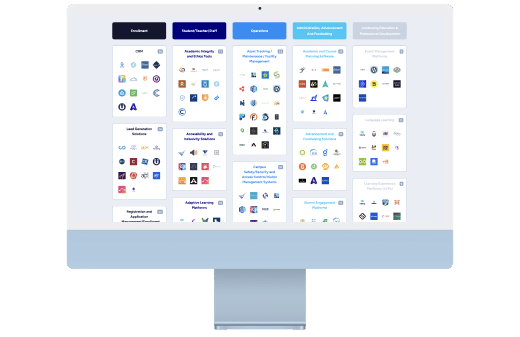Education Software M&A Experts
Learning the Ropes: Navigating the Education Software Landscape
In line with various industries, the education sector is undergoing significant transformation. Behind the scenes, there’s a growing emphasis on academic, operational, and infrastructure improvements. We expect to see SaaS reshape education entirely, from classrooms and administrations to facilities and beyond. With nearly 20 deals spanning the education software space, we diligently monitor developments in this pivotal sector. The transformative changes underway are captivating, and we eagerly anticipate the trajectory it will follow.

Education Software M&A Overview
The active landscape of education software M&A activity mirrors the industry’s responsive stance towards pivotal trends reshaping the educational sector. Across this sector, significant trends are emerging that aim to change education for the better.
For example, there is a clear focus on personalized solutions for diverse academic needs with the goal of improving academic performance across all ages. Plus, operational and strategic capital improvements aimed at enhancing learning environments and better-preserving buildings and infrastructure are becoming essential for fostering academic excellence. We are also seeing a growing emphasis on administrative solutions, such as data analysis and reporting. Moreover, there is a heightened need for platforms facilitating communication and ensuring compliance with regulations and record-keeping.
The education industry is actively engaging in M&A activity, a must for companies hoping to remain adaptable to the changing landscape. Stay informed about these transformative industry trends by subscribing to our newsletter for the latest updates.
Education Software
Annual M&A Deal Volume
Educational Software Categories Overview
K-12
Software tools utilized in K-12 education encompass a diverse array of applications designed to streamline administrative operations processes, facilitate teaching and learning, and foster collaboration among students, educators, and parents. These tools include Learning Management Systems (LMS) tailored for the K-12 environment, interactive whiteboard software for engaging classroom presentations, and educational games and apps designed to enhance student learning and engagement. Additionally, communication platforms play a crucial role in connecting teachers with students and parents, facilitating effective collaboration and parent-teacher communication.
Higher Education
Software tools utilized in higher education encompass a diverse array of applications designed to streamline administrative processes, preserve facilities and assets, facilitate teaching and learning, and foster collaboration among students and faculty. Tools include Learning Management Systems (LMS) for course delivery and student management, plagiarism detection software to uphold academic integrity, and communication platforms for seamless collaboration.
Continuing Education
Software tools in continuing education cater extensively to adult learners and professionals, encompassing a broad spectrum of resources such as online learning platforms, webinar software, and career development platforms. These versatile products serve as indispensable resources, empowering individuals not only to pursue lifelong learning but also to navigate career advancement opportunities with efficiency and effectiveness.
Private Equity's Pursuit: The Appeal of Education Software Investments
Investors and strategic buyers are increasingly attracted to education software companies due to their pivotal role in modernizing the educational landscape.
The regulatory landscape in education underscores the importance of compliance frameworks, prompting organizations to seek software solutions to ensure adherence to standards and regulations. Additionally, administrative solutions designed to address strategic budgeting and other administrative issues are poised to support administrative staff effectively.
These factors collectively highlight the attractiveness of education software companies as lucrative investment opportunities within a dynamic and evolving sector. Specifically regarding buyer trends, private equity investors have emerged as predominant players in the education software sector, with over 60% of deals over the past five years driven by PE buyers. This shift in the investor landscape signifies a significant trend, demonstrating the increasing recognition of the strategic value and growth potential within the education software industry by private equity investors.
2023 Education Software M&A Activity by Buyer Type
Trends Defining the Education Sector Today:
The education sector is experiencing a profound shift driven by initiatives to support educators, personalize learning, and prioritize mental health for students and staff. This includes efforts to boost teacher compensation, promote equitable access to education, and invest in technology like cloud-based platforms to bridge the digital gap. Simultaneously, states like Indiana and Massachusetts are pioneering education system reforms while addressing college affordability and expanding career pathways to prepare students for the evolving job market. Technological innovations such as AI and gamification are enhancing student engagement, while infrastructure investments modernize educational facilities for conducive learning environments. These collective endeavors aim to create inclusive, flexible, and innovative educational ecosystems that empower learners to thrive in an interconnected world.
Browse some of the key tailwinds driving growth in the education software space.
Tailwinds Propelling Education's Digital Transformation
Educator Support Initiatives: Enhanced compensation, expanded pathways into the teaching profession, and prioritization of educator mental health initiatives are driving forces fostering a digitally transformed education landscape.
Technological Innovation: The adoption of cloud-based platforms, AI-driven insights, and gamification strategies are revolutionizing teaching methods, student engagement, and administrative processes, propelling the digital transformation in education.
Infrastructure Investment: Investments in modernizing educational facilities and leveraging Industry 4.0 technologies like VR/AR and IoT devices are pivotal in creating conducive learning environments and better preservation of facilities/assets and driving the digital evolution of educational institutions.
Educational Equity and Access: Initiatives promoting equitable access to education through technology, including efforts to bridge the digital divide and provide personalized learning experiences, are key tailwinds propelling the digital transformation of education.




